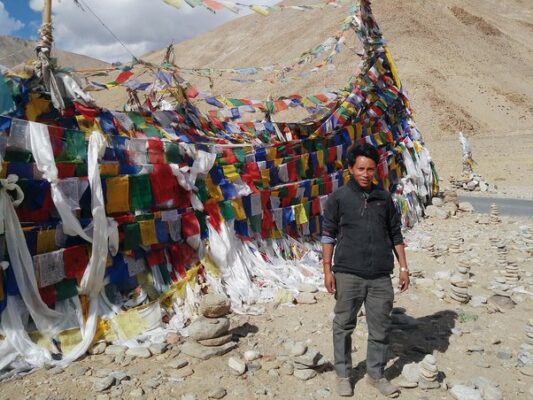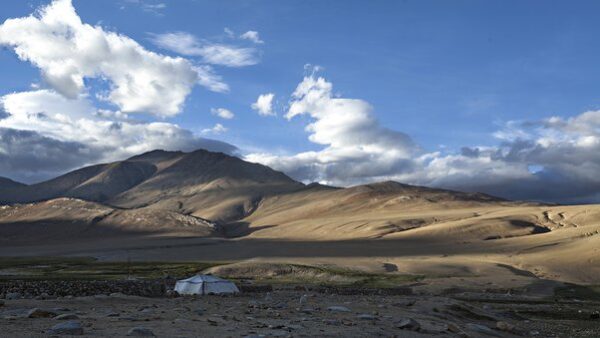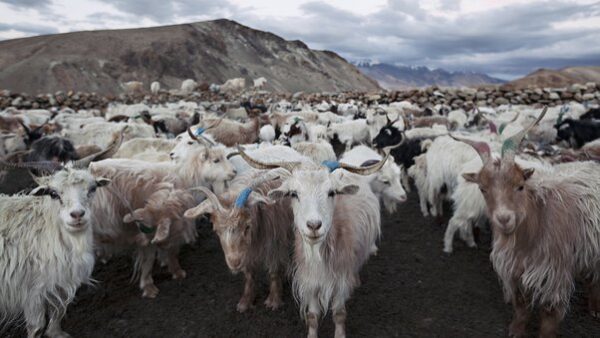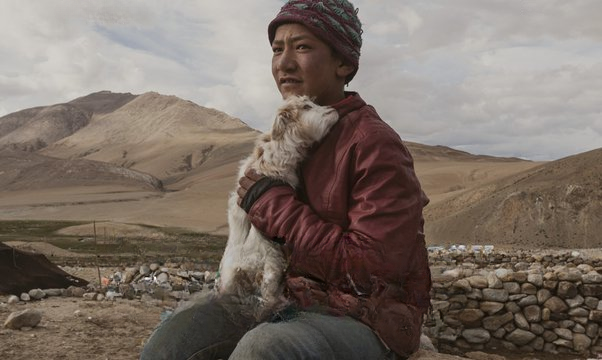For centuries, the people of Changpa have gracefully tread the Himalayan plateau. Now, they confront the repercussions of climate change.
The vanishing of culture is not a sudden applause into the abyss, akin to the extinction of species. It is a slow fading of a way of life, an endless struggle to maintain identity in a world that keeps revolving while condemning them in myths. Skarma Lakpa, dwelling in the vast lands of the Himalayas in Ladakh, India, is a man well acquainted with the battle for survival. He seeks to seize every opportunity to connect with the version of himself that lived many years ago.
Lakpa belongs to the Changpa nomads of the Chantang plateau. These nomads have wandered within the harsh confines of their ecosystem for centuries, semi-nomadic beings. The Chantang plateau, towering over 14,000 feet, stands in the eastern part of Ladakh, India, stretching into Tibet across the border with China. It is truly a high-altitude realm. “Never sleep outdoors,” warns Lakpa, “If you sleep with half of your body exposed to sunlight and the other half in the shade, you’ll end up with sunstroke or frostbite,” he says. Swirling clouds in the azure sky cast intense shadows on the seemingly endless dusty terrain. The mountains are studded with minerals and rocks, creating fluid hues of purple, green, brown, blue, and black. Like gods, the Himalayan range looms thunderously, no matter how far the road extends.
Today, Lakpa works part-time in the most populous city in Ladakh, Leh. On weekends, he eagerly awaits the return to the isolated village of Korzok nestled in the untouched nature of Chantang. His mother resides there, and other family members, whom he rarely sees on weekdays. Lakpa transports locals and tourists, without means to reach Korzok, on a rusty and rattling Maruti Suzuki for a six-hour journey. I met Lakpa during this journey. I quickly realized that despite the Changpa nomads living in harmony with nature for centuries in the vulnerable region of Hindu Kush Himalayas, they are the most impacted by climate change.
Heading towards Korzok in the battered Maruti Suzuki, every part seemed tied together with ropes, creating a cacophony. With each pothole, we were thrown into the air, and I, like a ragdoll, collided with the window glass. Yet, apart from an unprepared hitchhiker, no one seemed perturbed. Lakpa, with his small stature, bounced around like us but maintained a constant smile throughout most of the journey. That smile spread through the rugged face, reaching his black eyes. He looked much older than his 29 years, with deep wrinkles on his profile, exposed to the harsh sun of the Himalayas, where he had lived for many years. The rocky road and the wind scattering sand on the windows couldn’t steal his sunlight.
He frequently shared folklore, tales of mountain legends, Buddhist monks and their journeys, and the origin of Tso Moriri Lake’s name. These stories seemed more like a way for him to relive them.
His stories carried a nostalgic tone, narrating how nomads intimately know the land. “My grandmother used to say, ‘Don’t kill wolves because the mountains will get lonely,'” he recounted. Changpa nomads practice coexistence with humanity, showing deep respect for the surrounding world. Their spirituality is rooted in Buddhist animism. Every tree, mountain, river, and animal lives akin to them. Season by season, they traverse the plateau, knowing the land like their own bodies. Despite being perceived as illiterate, the richness of their knowledge, passed down through generations and narrated through songs and stories, is invaluable. “This land is rich in nutrients and medicine. Amchi (Changpa healers) know which mountain flower works as an antibiotic, which shrub or herb boosts vitality, and what can be used to cure headaches, ulcers, and colds,” Lakpa affirmed.

Once, Lakpa led a semi-nomadic life in the Himalayas, tending to goats, yaks, and horses. Now, he does odd jobs in the town of Leh.
From a young age, Lakpa forged a deep connection with the land. In his childhood, alongside his mother, he confronted the harsh climate of the cold desert and the rugged peaks and outcrops of the Himalayas in search of lush grazing grounds for goats, yaks, and horses. “I was a restless child, never short of things to play with. If I could get my hands on an empty can, it brought immense joy. I’d tie this noisy can with a bit of string, drag it around, running through the infinite emptiness,” he reminisces.
As Lakpa suggested stopping by a nomadic settlement on the way to Korzok, none of the passengers opposed. With a slight turn of the steering wheel, we veered off the dusty road, leaving behind the serpent-like trail closing in from behind. Suddenly, we halted in a meadow, where the blue Himalayan mountains descended, crossing a sponge-like green floor, with the babble of a stream flowing. Lakpa opened the trunk, shouldering supplies like rice and lentils. Heading towards the traditional yak-hair tent called “Rebo,” made near a rudimentary livestock shed, he sprinted. An old woman with silver hair, resembling a glacier, worked on a worn-out loom nearby. She greeted Lakpa with a smile, and they immediately engaged in conversation.
As the sun began to set, nomads from various districts herded hundreds of Pashmina goats safely back to their pens on the distant mountain. White and brown goats spilled down from the summit, approaching us like a slow-moving army. The herd returned leisurely, stopping every few meters to graze. Near my ankles, a young one bleated weakly. Running my fingers through its wool felt like reaching into the clouds. Pashmina wool, with a diameter of 12-15 microns, is considered one of the finest in the world among cashmere wool. Nomads seek high-altitude locations as robust fur doesn’t grow in warmer regions. Formerly engaged in trade along the Silk Road, they now sell combed wool to state cooperatives or private dealers in nearby cities.
Smoke spiraled from the chimney protruding from the Rebo’s peak, and the old lady welcomed us with chai. A large metal trunk served as a makeshift chair; possessions were minimal. In the warmth of the tent, fresh goat milk boiled on a Tibetan stove, filling the air with a sweet aroma. The fuel, a mix of dung, urine, and dried shrubs, burned throughout the day to withstand temperatures below minus 30 degrees Celsius during the glacial periods. Though words didn’t bridge the gap, the old woman approached me, silently replenishing the cup with hot creamy chai each time I looked at the bottom.
A young mother cradled a baby on a rug laid on the floor. Her husband was still outside, persuading goats to return to the shed. Lakpa mentioned the Changpa nomads’ polyandrous system, where brothers marry the same woman, and the household can’t split property or herds among families. To my inquiry about jealousy, he replied, “Jealousy? No, when your wife is loved and cherished by those you hold dear, there’s no room for jealousy. We’re all one big family.” Yet, the younger generation, exposed to a broader culture over the years, is increasingly moving away from this tradition, favoring monogamy. This change has led to a shortage of labor in some households.
As darkness encroached, we headed towards Korzok, a mirage-like village nestled in the dusty brown mountains, blending with unpainted stone and mud houses. After enjoying Momos and Thukpa with Lakpa, we returned to the modest room in a guesthouse near the Korzok Monastery.
Before dawn, breaking the night’s silence was the sound of a long horn from the monastery. Inside the prayer hall, monks sat before golden Buddha statues, chanting deep scriptures resonating within the monastery that bore a history spanning five centuries, reaching the alleyways of the village. This day marked the Korzok Gustor festival, a customary celebration where nomads from various Chantang regions gather, offering prayers and sacrifices to the spirits for a bountiful year.
Gourmet Dorje, a former nomad and current chairman of the Ladakh Autonomous Hill Development Council, was the guest of honor. “The Changpa people hold great hope in the Korzok Gustor and their protective spirits,” he said after the festival. With much of their lives beyond their control, it’s only natural.
The Changpa nomads, who have roamed this land as pastoralists since their migration from Tibet in the 8th century, don their finest attire for this occasion. Men wear layers of yak fur, while women adorn themselves with decorations resembling hoods adorned with Himalayan turquoise and lapis lazuli, resembling cobras. Infants peek out from their mothers’ backs. Everyone gathers on corridors and rooftops to watch as monks perform the Dharma dance.
This time, the chief guest was Gourmet Dorje, a former nomad and the current chairman of the Ladakh Autonomous Hill Development Council.
“The Changpa people place great hope in the Korzok Gustor and the spirits that protect them,” he said after the festival. Given that much of their lives is beyond their control, it seems only natural.
The nomadic life of the Changpa people once yielded profits surpassing agrarian households. However, they now face changing circumstances due to climate change and the prosperity of tourism in Ladakh.
Chantang, situated in the Hindu Kush Himalaya region, the world’s second-largest repository of snow and ice after the polar regions, is experiencing warming at a rate significantly higher than the global average. Data suggests that between 1973 and 2008, temperatures in Ladakh rose by 3 degrees, whereas in other regions of India, it increased by only 1 degree. Nomads lament the reduced snowfall in recent decades, a sentiment reflected in climate studies in the region. From 2013 to 2017, Ladakh’s annual precipitation has decreased by 50% to 80%. Glaciers, once beloved by nomads, have also started to recede. Scientists estimate that Indian Himalayan glaciers lost an average of 19% in volume from 1984 to 2012, with 67% disappearing from lowland glaciers during the same period.

In the Hindu Kush Himalaya region, climate change has led to dramatic shifts, including rising temperatures, decreased snowfall, and the retreat of glaciers.
The repercussions extend to the lives of around 210 million people residing in the Hindu Kush Himalaya region and another 1.3 billion people in downstream river basins. According to Jayaraman Srinivasan from the Indian Institute of Science in Bangalore, “Rising temperatures are affecting the cycle of snow and rain. When it rains in the desert, it pours for a short duration, causing catastrophic damage. In such places, there is no capacity to deal with rain.” In Ladakh, flash floods, landslides, and rockfalls have increased over the past decade, resulting in several hundred deaths and damages worth 20 million USD. Traditional homes made of wood, stone, mud, brushes, grass, and clay cannot withstand heavy rain. Additionally, reduced precipitation has led to decreased water flow in rivers flowing through villages, sparking disputes over water within the local communities.
Once predominantly agrarian, the villages of Ladakh are now facing challenges due to lower harvests caused by erratic rainfall in recent years. Agriculture is taking a backseat to more lucrative fields such as tourism. The tourism boom has seen Ladakh’s annual tourist numbers surpass 250,000 in recent years, a tenfold increase from 2002. While many benefit from tourism, there is also a growing concern about the environmental degradation it brings. Springs that once quenched the thirst of Leh, the local capital, are now choked with plastic and waste, turning murky brown. Despite locals still using traditional dry compost toilets, upscale hotels are drawing groundwater from private wells, exacerbating water scarcity. According to Ladakh Ecological Development Group (LEDEG), an environmental NGO based in Leh, an average Ladakhi uses 21 liters of water per day in summer and 10-12 liters in winter. In contrast, a tourist requires 75 liters per day.
As weather predictions become more challenging, pastoralism becomes an increasingly perilous occupation. “From December to March, it’s the most vulnerable time for pastoralists, with the risk of frostbite, shortages of food and fodder,” says Dorje. A single blizzard can result in the death of thousands of animals in a region, leading to hunger and high fever. Such significant losses plunge pastoralist families into poverty, sometimes necessitating a change of profession to sustain life. In the Chantang Plateau in 2013, unexpected heavy snowfall led to the death of over 25,000 Pashmina goats. “Without support from the Indian Ministry of Textiles, I believe the number would have exceeded 70,000,” says Dorje. At that time, the Indian government incentivized Champa with aid such as winter feed, subsidized food supplies, and nutritional supplements for cattle to promote Pashmina production. However, the government formed in 2015 discontinued all support. “This had a significant impact on pastoralists,” Dorje states. “Pastoralists were accustomed to nutritional supplements and feed. The abrupt ban on supplements adversely affected animal health.”
Challenges in this region go beyond climate change. Once, the lush grazing lands of the Changpa extended over 100 miles from Chantang to Lhasa. However, significant shifts in national borders occurred after India recognized the exile of the Dalai Lama in 1959, leading to intense conflicts with neighboring China. Much of Chantang came under Chinese control, and the nomadic pastoralists of the Changpa, residing in India, were forbidden from traversing the lands they had roamed for centuries. They lost winter grazing grounds in the Skagjung area. Many believe that China continues to encroach on their territory. “Even if we inform government officials of such a situation, the government dismisses our claims and denies any encroachment on the land,” Dorje states.

In the Himalayas, as weather predictions become elusive, pastoralism transforms into an increasingly challenging occupation, posing a threat to the herds of cattle and the livelihoods of nomadic herders.
Dorje also points out that wildlife conservation is impacting the lives of nomadic communities. Regions like Changtang, home to rare and endangered species such as snow leopards and Tibetan gazelles, are protected under wildlife conservation laws. “However, the designation of Changtang as a wildlife sanctuary prohibiting human activities has once again expelled nomads from their own lands,” says Dorje. “Preserving ecosystems is crucial, but nomads are not a menace. We live in harmony with the ecosystem.”
Currently, nomads find themselves torn between their identity and livelihoods. Those unable to sustain the nomadic lifestyle increasingly migrate to urban areas to secure even a modest income. According to surveys, while there were around 4,000 Changpa nomads in Changtang in 1995, the number has now dwindled to less than 1,200. Even when thrust into urban life, as is the case with many migrants from rural India, most end up living on the fringes of society. “If the current trend continues, Changpa nomads may cease to exist within 20 years,” warns Dorje.
Rakpa, a young man, abandoned his nomadic life about six years ago. The morning after a fierce snowstorm that year, he discovered the scattered corpses of his goats. Having lost his father that year, the weight of the world suddenly descended upon him. The nomadic lifestyle was no longer sustainable for him and his mother.
Now, he assists his aunt, who runs a guesthouse in Korzok over the weekends, and manages a small restaurant named “Skarma’s Organic Cafe.” He explains with a wink, “Yes, all the village produce is organically grown, but we kept the name to attract tourists.” While most of Korzok’s villagers have nomadic roots, they now earn a living through Ladakh’s burgeoning tourism industry.
Assimilating into this new world is no easy feat. According to Rakpa, nomads are often perceived as uneducated, dirty idlers. Like people worldwide, nomads are striving for a better future for the new generation. In 2007, the “Nomadic Residential School” was established in Puga village in Changtang, aiming to provide a lifestyle free from the norms of nomadic habits.
The spacious school hall echoes with the screams and laughter of children playing, depicted on the walls are apples and poplar trees. “Many of the children are familiar with shrubs and grass but not so much with large trees. So, these paintings resemble real trees,” explains the school’s math teacher.
For nomads, this school is a double-edged sword. While it equips children with essential tools to survive in the outside world, it takes away valuable experiences learned by walking the plateaus, caring for livestock, and studying the mountains.
By touching the outside world, children can dream boundlessly. When asked what they aspire to become one day, responses range from tour guides and teachers to engineers. However, some express a shy desire to return to nomadic life. “We don’t tell children what they must become or which path to follow. Whether an engineer, artist, teacher, or doctor, we just remind them not to forget to return to their land and contribute to the people with their skills,” says the principal.
While climate change paints a harsh future for the planet, the school teaches children traditional nomadic songs – songs of hope, songs praising nature, and songs emphasizing the importance of coexistence. More crucial than math or grammar is instilling knowledge about their own culture and history. It acts as a shield when they step out into society, a pride in knowing where they come from.
Every morning, students gather on the earthen ground, and amid the biting cold and darkness of the high plateau, a chorus of a hundred cheerful voices sings songs that have supported people through the metaphorical deathly chill of the plateau.


